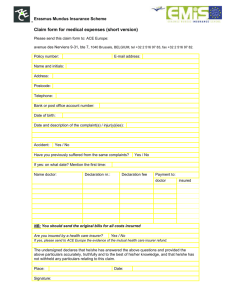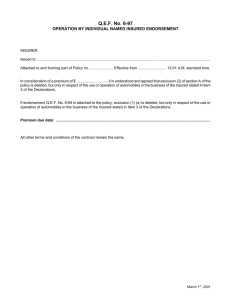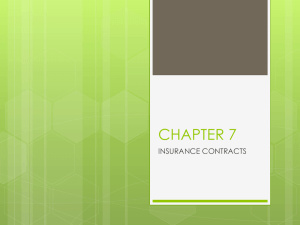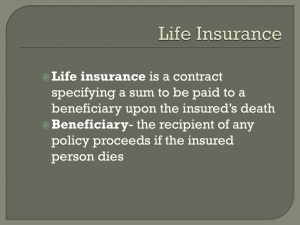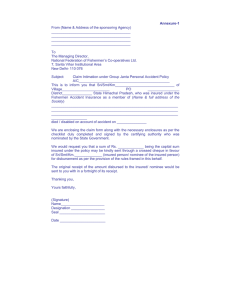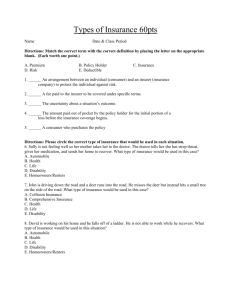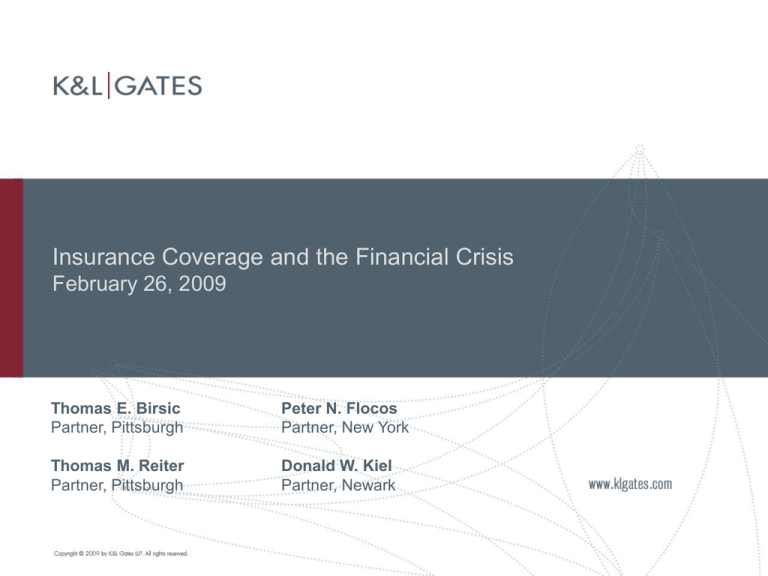
Insurance Coverage and the Financial Crisis
February 26, 2009
Thomas E. Birsic
Partner, Pittsburgh
Peter N. Flocos
Partner, New York
Thomas M. Reiter
Partner, Pittsburgh
Donald W. Kiel
Partner, Newark
Presenters
Thomas E. Birsic, Moderator,
a partner at K&L Gates,
maintains an active trial,
arbitration and counseling
practice focused principally
on insurance coverage and
commercial disputes.
Donald W. Kiel, Presenter, a
partner at K&L Gates,
concentrates his practice on
complex commercial litigation,
including commercial
insurance coverage litigation
and counseling.
Thomas M. Reiter,
Presenter, a partner at K&L
Gates, concentrates his
practice on
representing businesses,
with a particular emphasis
on financial institutions, in
complex insurance coverage
matters and claims disputes.
Peter N. Flocos, Presenter, a
partner at K&L Gates, whose
practice concentrates on
business and commercial
disputes, including insurance
coverage litigation and "deal
litigation" disputes.
2
Outline of Presentation
Types of investigations, lawsuits and losses faced
by companies as a result of the financial crisis
Coverage afforded by Directors and Officers (D&O)
policies
Coverage afforded by Errors and Omissions (E&O)
policies
A discussion of selected “hot button” insurer
coverage defenses with some thoughts on how to
overcome these defenses
3
Worldwide Financial Crisis Headlines
“Stanford Financial: SEC Accuses Texas Firm of CD
Fraud,” U.S. News and World Report (Feb. 17, 2009)
“Worldwide Crisis Could Destroy Globalization,” The
Herald (Glasgow) (Jan. 16, 2009)
“Madoff Investors to Sue UBS, HSBC, Medici, E&Y,”
Reuters (Feb. 4, 2009)
4
Worldwide Financial Crisis Headlines
"Livid Investors Launch a Volley of Lawsuits: Class
Actions Mount Despite Uncertain Payouts for Those
Who Lost Money," The Washington Post (Jan. 18,
2009)
"Criminal Crackdowns Brewing in Financial Services
Sector Mess," Chicago Tribune (Jan. 12, 2009)
"Financial Crisis Spawning Lawsuits," Business
Insurance (Nov. 17, 2008)
5
What is the Financial Crisis?
Significant write-down of the value of corporate assets
Dramatic declines in market values of major corporations
Increased delinquencies, defaults and foreclosures
Significant bankruptcies in financial services, retail and other
sectors
Collapse of corporate deals resulting from credit crunch or
other circumstances
Madoff (and other Ponzi scheme) fraud resulting in claims
against investment managers, advisors, etc.
6
Who are the Parties suffering losses and liabilities?
Borrowers and investors
Investment managers and advisers
Hedge funds, mutual funds and other investment
vehicles
Virtually all of corporate America
Private equity firms
Underwriters
Auditors
7
What are the actions being pursued?
Administrative enforcement actions
Shareholder class actions
Individual consumer and investor class actions
“Commercial” disputes between industry
participants over failed deals, etc.
8
Directors and Officers (D&O) Insurance
D&O coverage is a first line of defense for a host of
claims and actions
9
D&O Grant of Coverage
PART A:
The Company shall pay, on behalf of the Insured Persons, Loss for which the
Insured Person is not indemnified by the Organization and which the Insured
Person becomes legally obligated to pay on account of any Claim first made
against the Insured Person during the Policy Period for a Wrongful Act.
PART B:
The Company shall pay, on behalf of the Organization, Loss for which the
Organization grants indemnification to an Insured Person, as permitted or
required by law, and which the Insured Person becomes legally obligated to pay
on account of any Claim first made against the Insured Person during the Policy
Period for a Wrongful Act.
PART C:
The Company shall pay, on behalf of the Organization, Loss which the
Organization becomes legally obligated to pay on account of any Securities
Claim first made against the Organization during the Policy Period for a
Wrongful Act.
10
Private Company D&O Insurance Coverage
Part C — “Entity Coverage” — may be expanded to
cover all “Claims” as defined by Policy.
Part C coverage may not be limited “Securities
Claims.”
11
Definition of “Wrongful Act”
Wrongful Act means:
(a) any error, misstatement, misleading statement, act,
omission, neglect, or breach of duty committed,
attempted, or allegedly committed or attempted by
an Insured Person in his or her Insured Capacity, or
for purposes of coverage under Part C, by the
Organization; or
(b) any other matter claimed against an Insured
Person solely by reason of his or her serving in an
Insured Capacity.
12
Definition of Loss
Loss means the amount the Insured Person (for purposes of
Part A and B) or the Organization (for purposes of Part C)
becomes legally obligated to pay on account of any covered
Claim, including but not limited to damages, judgments,
settlements, pre-judgment and post-judgment interest and
Defense Costs.
Typically “Loss” will not include punitive damages, taxes,
fines, penalty and the multiplied portions of damage awards.
To the extent these items are insurable, they may be included
by negotiation. Restitution may not be insurable.
13
Definition of Defense Costs
Defense Costs means that part of Loss consisting
of reasonable costs, charges, fees (including but
not limited to attorneys’ fees and experts’ fees) and
expenses incurred in defending any Claim and the
premium for appeal, attachment and similar bonds.
Defense Costs in a D&O policy typically reduce the
available policy limits.
14
Potentially Applicable D&O Exclusions
Fraudulent/dishonest conduct
Personal profit
Known claims
15
Errors and Omissions (E&O) Insurance
The wave of claims and actions also may
trigger coverage under E&O insurance
policies.
16
E&O Overview
Overview of E&O Terms
Differences between E&O and D&O
Potential Claims that May Trigger E&O Coverage
Potential Defenses
17
What is E&O Coverage?
E&O is the “general rubric” used to describe many types of
insurance that protect persons or entities that render
“professional services” for liabilities arising from errors or
omissions committed while rendering such services, usually
for a fee or commission.
Terms vary widely by industry and often are narrowly tailored
to “professional services” of particular industry.
Terms vary widely not only by industry, but also by insurer
within an industry group.
18
Typical E&O Insuring Agreement
“To pay on behalf of the Insured all sums which the
Insured shall become legally obligated to pay as
Damages resulting from any Claims first made
against the Insured and reported to the Insurer
during the Policy Period … for any Wrongful Act of
the Insured or any other person for whose actions
the Insured is legally responsible, but only if such
Wrongful Act … occurs solely in the rendering or
failure to render Professional Services.”
AIG, Mortgage Bankers/Mortgage Brokers E&O Insurance, 63530 (3/96).
19
E&O v. D&O
The line between D&O and E&O is not always clear, and
certain lawsuits may potentially trigger coverage under both
lines of coverage.
“Professional Services”
D&O policies generally exclude claims related to rendering of
“professional services.”
E&O policies expressly afford coverage for “professional services.”
“Insured”
D&O (directors and officers and, in limited circumstances, company
and/or employees).
E&O policies often define “Insured” more broadly to include the
company itself, as well as directors, officers, employees, and thirdparties for whose actions the Insured is legally responsible.
20
Definition of “Professional Services”
Some policies define “professional services”
generically:
One policy defines Wrongful Act as certain errors or
omissions committed by the Insured “solely in the
performance of or failure to perform professional
services for others in the Insured’s Profession as
stated in Item 1.A. of the Declarations.” London,
Specimen SUA MCPL 04.
Many policies specifically define “professional
services” based on industry of policyholder.
21
Definition of “Professional Services”
Lenders (“the origination, sale, pooling and servicing of
mortgage loans secured by real property …”).
Financial Services firms (“services that an Insured renders
pursuant to an agreement with a customer or client, as long as
the customer pays a fee, commission, or other compensation
…”).
Investment Banks (“those services performed … by the Insured
(or by any other person or entity for whose acts, errors, or
omissions the Insured is … legally responsible) for, for the
benefit of, or on behalf of a Customer … for a fee, commission
or other consideration”).
22
Claims That May Trigger E&O Coverage
Given wide array of potential claims and
potential defendants, it is difficult to even begin
to list the potential types of claims.
Imperative to compare specific allegations
against specific policy language.
23
Other Potentially Relevant Insurance Policies
DON’T FORGET ABOUT OTHER TYPES OF
COVERAGE
General Liability
Fiduciary Liability
Employment Practices Liability
Blanket Bonds
Others
24
Pathway To Accessing Insurance Coverage
Overview (6 Critical Areas)
Is there an Insured?
Is the standard of conduct covered?
Is the type of conduct (sphere of business activity)
covered?
Is the type of alleged injury covered?
Is it a “Claim” and, if so, how many claims?
Does the policyholder’s claims-related conduct limit
or eliminate coverage?
25
THREE SELECTED ISSUES
1. Standard Of Conduct
Is the Insured’s Conduct Sufficiently Egregious to Fall
Outside Coverage?
Fraud/Dishonesty Exclusions/Limitations
“Alleging”
“In Fact”
Final Adjudication (underlying claim v. coverage
action)
Defense Costs (return thereof)
The Adjectives (“deliberate,” “intentional,” “willful,”
“active” & “deliberate”)
26
Standard Of Conduct
Imputation
Public Policy/Uninsurable As A Matter of Law
Misrepresentation/Recission
Common Law
Severability/Scienter
Policy Applications
Wrongful Act (Negligence)
Continuity Date
27
2. Disgorgement/Restitution
Common Law
Policy Wording
Loss Definition
Exclusions
28
3. Claim-Related Issue
Do the facts surrounding the coercive action bring it within
coverage?
Is it a “claim”?
Investigations
Proceedings
Criminal Matters
Foreign
Pre-Claim
Cost of Correction
Relatedness
29
Claim-Related Issue
Why the Issue Matters
Per Claim Self-Insurance
Per Claim Limits/Sub-Limits
Trigger Issue
Telescoping Provisions
Notice of Circumstance
Stacking
30
Claim-Related Issue
Exclusions
Prior Notice
Prior Made
Tests
Policy Language
Definitions (“Interrelated”/ “Related”)
Wrongful Act vs. Claim
Case Law
Common Cause
Other
Mixed Claims
Insured v. Insured Exclusion
31
Certain Purported “Conditions” to Coverage and Other
Policy Provisions – D&O/E&O Policies Generally
“Notice” – insurer may claim that under the policy
notice of the “Claim” itself must be given within some
time frame (promptly, as soon as practicable or some
other formula)
notice of circumstances that may reasonably be
expected to give rise to a “Claim” must be given
within some time frame (promptly, as soon as
practicable, some other formula)
32
Certain Purported “Conditions” to Coverage and Other
Policy Provisions – D&O/E&O Policies Generally
“Notice”
Many jurisdictions, by statute or decisional law, will
not necessarily enforce “notice” provisions as written
e.g., will not permit coverage to be forfeited unless the
insurer was materially prejudiced by the supposedly “late”
notice
Easier if the policyholder simply avoids any insurer
claims about “notice” by giving prompt notice under
all potentially implicated policies
33
Certain Purported “Conditions” to Coverage and Other
Policy Provisions – D&O/E&O Policies Generally
Insurer may claim that under the policy, it has the right to
approve incurrence of defense costs or approve insured’s
defense counsel
Insurer may claim that the insured is required to use preapproved “panel counsel” (at least for certain types of claims,
e.g. “Securities Claims”)
Insurer may claim that “litigation guidelines” must be followed
Insurer may claim that under the policy, it has the right to
“effectively associate” in the defense and/or settlement
negotiations
34
Certain Purported “Conditions” to Coverage and Other
Policy Provisions – D&O/E&O Policies Generally
Insurer may claim that under the policy, the insured must
“cooperate” with the insurer in connection with the defense
Insurer may claim that under the policy, information requested
by the insurer must be provided by the insured
Insurer may claim that under the policy, it has the right to
consent to any settlement
Even if insurer consent is required, it is often the case that the
consent cannot unreasonably be withheld, at least so long as
the insurer was given the right to “effectively associate” in the
defense and/or settlement negotiation
35
Certain Purported “Conditions” to Coverage and Other
Policy Provisions – D&O/E&O Policies Generally
Potential issues regarding waiver of attorney-client
privilege or work product in claims handling contexts
Insurers contend that privilege or work product is
waived if communications between insured and its
attorneys are shared with a broker– easier to avoid
the debate simply by exercising caution about what is
shared with a broker
Waiver issues also may exist if privileged or work
product material about the underlying case is shared
with the insurer itself
36
Certain Purported “Conditions” to Coverage and Other
Policy Provisions – D&O/E&O Policies Generally
ADR provisions
mandatory mediation before suit
binding arbitration
Governing law provisions
Jurisdiction or venue provisions
37
Other “Best Practices” – D&O and E&O Policies
Generally
Be able to show lack of prejudice to insurer from any purportedly
“late” notice (even though insurer may have the burden of proof)
Protect the record so that insurer cannot plausibly accuse insured of
failing to provide reasonable cooperation or to provide legitimate
information (being mindful of privilege-work product waiver issues)
Adequate documentation to support the necessity and
reasonableness of the defense costs expended
attorney bills
expert witness bills
other invoices (e.g., mock trial expenses)
some type of record generated by counsel as to why the fees and
expenses were incurred (again being mindful of privilege-work product
waiver issues)
38
Conclusion
This presentation is necessarily summary in nature.
Specific situations require careful consideration of
the facts, policy language and the law.
39
Contact Information
To contact Thomas E. Birsic:
thomas.birsic@klgates.com
412.355.6538
To contact Donald W. Kiel:
donald.kiel@klgates.com
973.848.4064
To contact Thomas M. Reiter:
thomas.reiter@klgates.com
412.355.8274
To contact Peter N. Flocos:
peter.flocos@klgates.com
212.536.4025
40
K&L Gates comprises multiple affiliated partnerships: a limited liability partnership with the full name K&L Gates LLP qualified in Delaware and maintaining
offices throughout the U.S., in Berlin and Frankfurt, Germany, in Beijing (K&L Gates LLP Beijing Representative Office), in Singapore (K&L Gates LLP
Singapore Representative Office), and in Shanghai (K&L Gates LLP Shanghai Representative Office); a limited liability partnership (also named K&L Gates
LLP) incorporated in England and maintaining our London and Paris offices; a Taiwan general partnership (K&L Gates) which practices from our Taipei office;
and a Hong Kong general partnership (K&L Gates, Solicitors) which practices from our Hong Kong office. K&L Gates maintains appropriate registrations in the
jurisdictions in which its offices are located. A list of the partners in each entity is available for inspection at any K&L Gates office.
This document is for informational purposes and does not contain or convey legal advice. The information herein should not be used or relied upon in regard
to any particular facts or circumstances without first consulting a lawyer.
Copyright © 2009 K&L Gates LLP. All Rights Reserved
41

